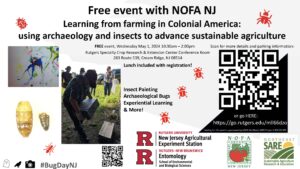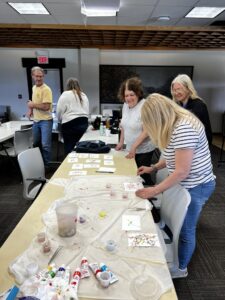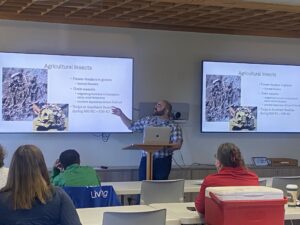Final report for GNE22-292
Project Information
In 1992 an excavation at the site of a seventeenth-century brick chapel at Historic St. Mary’s City, Maryland led to the discovery of three lead coffins interred under the structure. From the 1990s to the early 2000s a recovery and examination of the arthropod (insects and related animals) remains was completed. This project focused on these historical insect material found within the coffin of the landowner, Philip Calvert. The aim of this project was a novel approach to using insect data from the 1680s Calvert grave (i.e., archaeoentomology) for applications to sustainable agriculture. This project responded to the need for quantifiable data describing historical pest and beneficial insect species associated with American farms. Specifically, this project leveraged morphological and DNA analysis of archaeoentomology specimens for comparison to the modern site’s insect biodiversity. Recreating the coffin’s pre-burial storage conditions repeatedly across seasons was used to observe the modern local species attracted to a comparable environment. Our team completed a year-long survey of the site’s modern insect fauna using pitfall traps and a model of the coffin to collect carrion insects. The high abundance of primary predators of fly larvae, specifically rove beetles (Coleoptera: Staphylinidae), but also ants (Hymenoptera: Formicidae) and spiders (Araneae) were consistent with the low number of flies and associated remains found. A vacated puparium of the coffin fly Megaselia scalaris (Diptera: Phoridae) was identified morphologically within the coffin material and may be used to model conditions of colonization. Fewer pest insects in the modern survey may be indicative of wider biodiversity changes compared to the Colonial Period. The most frequently observed beetle in the modern survey, the hairy rove beetle Creophilus maxillosus (Coleoptera: Staphylinidae) was absent from the archaeological assemblage. This finding supports previous observations that C. maxillosus was naturalized to its current North American range. This project’s results demonstrate an integrative approach for using archaeoentomology material to measure changes in insects contributing to pest suppression services. Broadly, these methods can add to the menu of holistic options for pest management researchers.
- Attempted DNA identification of rove beetle and ant remains entombed in a 1680s American Colonial Period grave to draw conclusions about pest challenges at the site.
- Molecular identification was not successful during the project period when using both standard extraction methods and ancient DNA (aDNA) specifications. Over 20 attempts were made using individual insect head capsules and various methods. At the time of this report, it was our conclusion that storing the specimens long term (≥ 20 years) in 80% ethanol at room temperature was not conducive to preserving enough usable DNA in individual head capsules of rove beetles and ants. These results address gaps in basic science data about current limitations and uses of molecular analysis for archaeoentomology specimens.
- Completed a survey of the site’s modern insect biodiversity for comparison to historical remains
- Trapping modern insects at the site in Maryland was used to provide site-specific references for comparison to historical specimens.
- Finalize morphological identifications noting specific identifiable characters using updated morphological keys
- Given advanced imaging and other techniques, discerning morphologically identifiable characters and determining taxon identifications is the most time consuming and challenging parts of working with archaeoentomology material.
- Completing this work for the entire insect collection is on the horizon at the time of reporting due to the volume of material.
- Analyze data
- The completed data analysis will be reported in an article submitted to a peer-reviewed journal after the submission of the final report.
The purpose of this project was to address the need to use novel cross-disciplinary approaches to strengthen sustainable agriculture in the Northeastern USA. Our project aimed to do this by quantifying historical beneficial insect diversity and pest insect occurrence at an agrarian settlement in 1683 Maryland. The importance of pursuing this question was based in gaining a deeper understanding of the historical diversity of beneficial insects for the purpose of a long-term perspective on sustainable food security. For example, documenting the modern consistency of the beneficial predatory rove beetle C. maxillosus which likely had not yet established when Calvert was buried.
This study sought to address future issues in agriculture by expanding the scope of Integrated Pest Management to document changes in beneficial insect biodiversity in historical agricultural systems. This specifically addresses the need to study pest management from an evolutionary perspective by using time-calibrated historical specimens (Madison, 2016). An excavation at the site of a seventeenth-century brick chapel at Historic St. Mary’s City, Maryland in 1992 led to the discovery of three lead coffins interred within the structure. From the 1990s to the early 2000s a recovery and examination of the arthropod (insects and related animals) remains was completed. Over 41,000 arthropod fragments were recovered from within the coffins of the two adults. Consistent with insect remains from archaeological deposits, specimens consist mainly of fragments of arthropod exoskeleton (i.e., insects, spiders) and snail shells. The original analyses asserted the lack of fly (Diptera) indicated the insects assembled in winter. However, the presence of large quantities of primary predators of fly larvae, mainly rove beetles and ants (Hymenoptera: Formicidae) and apex predators (Araneae) suggests the coffins were stored for a period of time long enough to allow a complex microhabitat to form. The facial plate remains of one species of predatory true insects (Hemiptera) found with Calvert provide data on one aspect of natural pest suppression occurring during the Colonial Period. However, thrips (Thysanoptera: Thripidae) individuals found within the coffin suggests the agricultural operation may have experienced challenges from this common pest.
Cooperators
- (Researcher)
- (Educator and Researcher)
- (Educator and Researcher)
- (Educator and Researcher)
- (Educator and Researcher)
- (Researcher)
- (Educator and Researcher)
Research
Year-long site survey of modern insect fauna:
At the end of August 2023, we completed the year-long site survey of modern insect fauna through a pitfall trapping program comparing 2 sites (agricultural land, native meadow) and collecting carrion insects from deceased piglets placed in a model of the 1680s coffin twice per season. Samples were mailed to the Forensic Entomology and Wildlife Laboratory (FEWL) at Arizona State University for analysis.
Identification of historic insect specimens:
Debris from the bottoms of the coffin was collected for analysis after removal of human remains, grave goods and other associated artifacts. Debris subsamples were examined petri dishes for entomofauna remains (i.e., arthropods, snails) using a small pointed paintbrush Specimens were curated by taxonomic group in shell vials of 80% ethanol at room temperature in the Historic St. Mary’s City research laboratory. Insect fragments were observed under a dissecting light microscope and photographed. In many instances, specimens lacked key identifying characters due to their fragmented condition; this lead to identifications being approximated. Taxonomic keys, online pictorial references (e.g., BugGuide.net) and the Purdue Entomological Research Collection (PERC) were used as identification resources. DNA was extracted from individual insect head capsules, puparia, and larval segments using the QIAmp DNA Micro Kit (MPN: 56304, QIAGEN N.V., Hilden, Germany) following a modified version of the manufacturer’s protocol.
Analysis plan:
Collating the historical and modern data for statistical analysis was a project challenge. These challenges stem from comparing the single archaeoentomology assemblage as one sample with modern survey data, and from identification challenges inherent to archaeoentomology analysis. We attempted to mitigate this with DNA identification, which was not achieved during the project period.
Notably, the most frequently observed beetle species in the modern survey was the hairy rove beetle Creophilus maxillosus (Coleoptera: Staphylinidae). This included periods when C. maxillosus was the only species collected in the replicated coffin environment. No specimens in the archaeoentomology material were consistent with or identified as C. maxillosus. Together, these data support earlier hypotheses that C. maxillosus is not native to North America, but instead became naturalized after invading via the Columbian Exchange.
We identified the phorid fly Megaselia scalaris through a vacated puparium; indicating at least 1 individual of this species completed its life cycle within the Calvert coffin. The unexpected findings of adult dipteran remains in the form of an adult head capsule, the M. scalaris puparium, and several larval skins presented an opportunity to potentially gain further ecological data through future attempts at molecular identification.

We are excited that our small cohort of farmer attendees found value in our project and outreach programming. Collaborating on this educational program with NOFA-NJ allowed us to plan the activities with farmer input. This event further resulted in identifying Master Gardeners as a new stakeholder group interested in archaeoentomology. We began developing the upcoming fact sheet for Master Gardeners to cultivate this stakeholder interest.
Our hypothesis was: if a funerary archaeoentomology assemblage can be used as a proxy for local changes of insect baselines, then those changes can be measured by comparing the historical and modern insect groups. Our findings indicate Colonial Period trade may have had a noticeable taxon-based impact to the local insect biodiversity. This likely originated with the Columbian Exchange and the introduction, then later naturalization, of the hairy rove beetle Creophilus maxillosus (Coleoptera: Staphylinidae). One promising direction for future applied research is developing an emergence model for this naturalized beneficial predator species. This emergence model can then be a starting point from which to develop strategies to foster these populations of beneficial insects. For example, farmscaping and habitat manipulation which is further expanded on in the published article resulting from this project (Monzón, 2024). Our goal was developing applied archaeoentomology research so that it can be leveraged by landscape managers, restoration projects, or IPM researchers. Specifically, pest management research can weigh the promotion of naturalized versus historical beneficial species and integrate long-term agricultural entomology data for novel forecasting methods.
Education & outreach activities and participation summary
Participation summary:
Experiential learning workshop with research survey: Our collaborators and community partners presented the project through a workshop for farmers, master gardeners and other interested community members to get input from our local stakeholders. A total of 12 people participated in an all-day in-person workshop that included lunch. The workshop used an experiential-based learning format to provide an overview of the background material before engaging in hands-on activities mirroring project research. Afterward, attendees were asked to complete an IRB-approved research survey. The survey asked respondents if they felt the project benefitted sustainable agriculture and was used to illicit their feedback on how archaeoentomology research could be applied to agriculture. A total of 10 attendees (83.3%) responded to the survey. When asked if the project benefited sustainable agriculture, 8 responded “yes”, 2 responded “maybe” and 0 said “no”. Farmers were more likely to choose “yes” than non-agricultural community members while both self-identified Master Gardeners also chose “yes”. In feedback, farmers asked that future agricultural archaeoentomology research focus on Integrated Pest Management (IPM) and on-farm ways to sustainably produce maggots for poultry feed. Master Gardeners asked that similar outreach programing be offered to different county groups. Other attendees provided our team with actionable feedback that included ways to avoid pitfalls when examining archaeoentomology material and suggestions for leveraging historical ethnographic sources to find pertinent insect-related data. The workshop was held in collaboration with the New Jersey chapter of the Northeastern Organic Farming Association (NOFA-NJ). Promotion of the workshop was primarily through articles posted to the websites of NOFA-NJ and the Rutgers Plant & Pest Advisory.


Data for grower talk: Data generated by this project and associated background research for it have been used to provide historical context for a new on-farm food safety talk for growers. The talk details the on-farm food borne risks associated with some insect groups and highlights the best practices workers already have to mitigate these risks. This project provided data showing that these risks have been a constant feature of agricultural operations throughout history.
Upcoming fact sheet for Master Gardeners: A fact sheet is being developed to meet the interest of Master Gardeners indicated in the post-workshop research survey. The fact sheet will be published by the Purdue Cooperative Extension via the Purdue Department of Entomology. The current working title of the fact sheet is: “Insect exoskeleton remains commonly found in soils: recognition, limitations, and differences from plant tissue”.
Communication at professional conferences: The project and its current findings were presented through eight total conference talks. This included the 2024 Meeting of the Entomological Society of America (ESA) (≈30 attendees, Phoenix, Arizona, 11 November 2024), Council for Northeast Historical Archaeology (CNEHA) 2024 annual meeting (≈25 attendees, New Haven, CT, 19 October 2024), 2024 Ohio Valley Entomology Association (OVEA) Meeting (≈50 attendees, Lexington, KY. October 2024) Northeast IPM Research Update Conference (online, 16 November 2023). The project abstract was presented to 45 attendees during the introduction of an archaeoentomology symposium organized by the project leader at the 2024 International Congress of Entomology (ICE2024) (Kyoto, Japan, 29 August 2024). A conference poster was presented at the American (AMQUA) 2024 Biennial Meeting (≈100 attendees Salt Lake City, UT, 11 August 2024). Travel and presentation at OVEA and AMQUA were supported by additional travel awards.
List of other project-related talks delivered:
* denotes an invited seminar or lecture
- Surveying an insect collection from a 17th-century Northeastern agrarian settlement to determine changes in beneficial insects, pests, and climate”, Northeast IPM Research Update Conference. November 16, 2023
- * “Western Monmouth Utilities Authority (WMUA) Research Partnership Advances Understanding of Pathogens”, Annual Meeting & Conference of the Association of Environmental Authorities (AEA) of New Jersey, Atlantic City, New Jersey
- * “Using Insect Science to Address Research Needs of Indigenous Communities”, Várdduo - Centre for Sámi Research, Umeå University, Umeå, Sweden
- * “Using insect functional biodiversity of past decomposition environments to aid sustainable agriculture and disease ecology", Department of Ecology and Environmental Science (EMG), Umeå University, Umeå, Sweden
- * “Using insect biodiversity to investigate challenges of the past and formulate strategies for our future”, World Wildlife Fund (WWF) of Sweden, Stockholm, Sweden
- * “Applying the Principles of Forensic Entomology to Archaeological and Quaternary Investigations”, Seminar Series, Department of Historical, Philosophical and Religious Studies, Umeå University
Project Outcomes
Completing a well-documented and extensive year-long study of the site’s modern insect fauna is not a routine component of archaeoentomology investigations, though past archaeoentomology researchers have called for this practice to be more widely adopted. We hope that conducting this survey and reporting our methods in peer-reviewed articles with enough detail for reproducibility can provide new resources for this practice to be more accessible. While aDNA identification of insect remains was not successful during the project period, these outcomes provide a stronger foundation for similar future research endeavors. A beneficial outcome of this project is strengthening the ability to "hind-cast" past environmental conditions pertaining to agricultural production in the American Northeast.
Managing a large multi-state long term project, understanding the limits of using archaeoentomology material for DNA analysis, and conducting outreach to stakeholders were the three areas where knowledge gain was the most significant throughout this project. We believe that pairing extensive modern site insect biodiversity surveying through trapping of live insects has greatly benefitted our project and that this design should be more regularly incorporated into investigations of archaeoentomology. This is because modern site specimens have provided vital reference material from which comparisons to archaeological insect remains can be compared. Conducting the morphological analysis at the laboratory of the Environmental Archaeology Lab (MAL) at Umeå University under its Director, who is one of the few archaeoentomology experts in the world, enabled an international knowledge transfer experience. Bringing these skills back to the United States has begun to address this knowledge gap in American researchers.

Handling, processing and identifying archaeoentomology material is especially time consuming and presents several inherent challenges. However, the ubiquity of insects as features of farming ecosystems makes this type of tangible data valuable for understanding past environments.